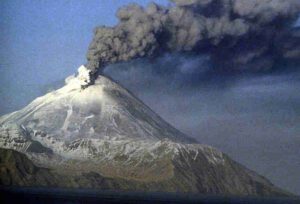5 Sources of Air Pollution Explained
Sources of air pollution are; volcanoes, deserts, automobiles, business outlets and electricity generation facilities.
They can be broadly grouped into natural and anthropogenic sources.
This article discusses the sources of air pollution, as outlined below;
-Natural Sources of Air Pollution
-Anthropogenic Sources of Air Pollution
-Natural Sources of Air Pollution
1). Volcanoes (as one of the Sources of Air Pollution)
A volcano affects the air by releasing materials that significantly alter air quality and composition.
Volcanoes cause air pollution because of the toxicity of their emissions, which can be both persistent and instrumental in causing human health problems and contributing to climate change.
Within the same context, it is important to note that the ecologic and environmental impacts of volcanic eruption as a natural disaster, may be traced mainly to its role in causing air pollution.
All the basic effects of air pollution can be caused by emissions from volcanoes. These volcanic emissions include sulfur dioxide, particulate matter, hydrogen fluoride, carbon monoxide and carbon dioxide [3].
Many volcanic gases are also greenhouse gases, that cause global warming. Others are airborne toxins that pose a threat to the ecosystem.
Volcanic air pollutants can also enter into seas and cause ocean pollution, or be dissolved in precipitation to form acid rain [5].

2). Deserts
Particulate matter from deserts is a notable cause of air pollution, especially in areas that occur in proximity to desert ecosystems or conditions.
This includes regions prone to desertification as a result of human activities like deforestation and industrialization; as well as regions that experience desert conditions naturally.
Air pollutants from deserts are transported by wind, into non-desert areas, and can pose serious health risks to the living populace, while causing environmental degradation.
The environmental impact of wind as a cause of air pollution, can be particularly severe in some cases, especially where pollution occurs in the context of natural hazards like dust storms.
Desert dust is mostly comprised of particulate matter, ranging in size classification from PM2.5 to PM10 [2].
These pollutants can be very hazardous in urban and semi-urban environments, as they are capable of mixing with other materials like airborne pathogens, volatile organic compounds and sea salt, to form highly-toxic aerosol.
Studies suggest that air pollution is partly responsible for increasing rates of infant mortality in sub-Saharan Africa [6].
-Anthropogenic Sources of Air Pollution
3). Automobiles (as one of the Sources of Air Pollution)
Automobile air pollution is a major environmental problem, accounting for up to two-thirds (or nearly 70%) of total air pollutant-emissions in urban areas [4]. It is arguable that cars are the greatest cause of air pollution in such areas.
Automobiles pollute the air by releasing byproducts of fuel combustion in their engines, from the exhaust.
These byproducts can include greenhouse gases and toxins, and can be highly poisonous, especially when they result from incomplete combustion.
The main sources of automobile pollutants are non-renewable energy resources and their derivatives; like gasoline from petroleum.
However, some automobiles that depend on renewable energy resources like biofuel, may also produce air pollutants [1].
Examples of air pollutants from automobiles include nitrogen oxides, sulfur dioxide, volatile organic compounds, carbon monoxide, and particulate matter.
Ground-level ozone is another harmful air pollutant that is formed when volatile organic compounds react with nitrogen oxides, under certain physicochemical conditions [7].
Aside automobile vehicles, other transport technologies like ships, submarines and aircrafts, can also act as sources of air pollution.
Efforts to reduce the effects of automobiles on air quality include electric car development, energy transition measures, fuel and energy efficiency improvement, and other forms of innovation.

4). Business Outlets
Most businesses involve activities that contribute to air pollution in one way or another.
These activities include raw material extraction, electricity generation, product manufacturing, supply or conveyance of materials and services, and routine maintenance.
Business premises themselves tend to produce air pollutants as a result of the use of energy for interior temperature regulation, and for powering appliances or equipment.
Companies causing air pollution are mainly those involved in energy production, electricity distribution, agriculture, manufacturing, or any other energy-intensive operation.
The relationship between air pollution and business operations, is a cause-and-effect one.
Businesses are affected by air pollution due to the impact of polluted air conditions on employee safety, health and wellbeing; as well as their productivity and the quality and safety of products or services rendered.
Air pollutants released from business outlets include particulate matter, sulfur dioxide, nitrogen oxides, volatile organic compounds, and ozone.
Efforts so far to reduce the contribution of businesses to air pollution include the development and enforcement of carbon trade policies, and the use of regulatory tools like carbon taxes and emission cut-offs to control the rate at which air pollutants are produced.
5). Electricity Generation Facilities (as one of the Sources of Air Pollution)
As a process and an activity, electricity generation can contribute significantly to air pollution.
Nearly all kinds of electricity generation facilities and equipment, including power plants, biorefineries, portable electric generators, and steam turbines, are linked to air pollution in one way or another.
It can be argued that the act of generating electricity is harmful to the environment, especially when unsustainable energy resources are being used.
The type of electric power generation that causes air pollution is mainly combustion-based electricity generation.
All systems that depend on fuel combustion as a primary process for generating electricity can cause air pollution, because of the byproducts that are released during fuel combustion.
Also, wasting electricity causes pollution, since the waste energy is usually released in form of heat, and alongside materials that can act as environmental contaminants.
Electricity generation is a major cause of air pollution globally, due to the need for electric power in all human-inhabited parts of the world, for nearly all economic and social operations.
Efforts to address air pollution coming from electricity generation, include energy conservation, renewable energy development, and the use of energy management systems among other sustainable innovations in power generation and transmission.
Conclusion
Sources of air pollution are;
1. Volcanoes
2. Deserts
3. Automobiles
4. Business Outlets
5. Electricity Generation Facilities
References
1). Anderson, L. G. (2012). “Effects of Biodiesel Fuel Use on Vehicle Emissions.” Available at: https://doi.org/10.3384/ecp110573645. (Accessed 1 December 2022).
2). Çapraz, Ö. (2021). “Particulate matter (PM10 and PM2.5) concentrations during a Saharan dust episode in Istanbul.” Air Quality Atmosphere & Health 14(3). Available at: https://doi.org/10.1007/s11869-020-00917-4. (Accessed 1 December 2022).
3). Delmelle, P.; Stix, J.; Baxter, P. J.; Garcia-Alvarez, J.; Barquero, J. (2002). “Atmospheric dispersion, environmental effects and potential health hazard associated with the low-altitude gas plume of Masaya Volcano, Nicaragua.” Bulletin of Volcanology 64(6):423-434. Available at: https://doi.org/10.1007/s00445-002-0221-6. (Accessed 30 November 2022).
4). Dey, S.; Mehta, N. S. (2020). “Automobile pollution control using catalysis.” Available at: https://doi.org/10.1016/j.resenv.2020.100006. (Accessed 28 November 2022).
5). Font, E.; Fabre, S.; Nedelec, A.; Adatte, T.; Keller, G.; Veiga-Plres, C. C.; Ponte, J.; Mirao, J.; Khozyem, H.; Spangenberg, J. E. (2014). “Atmospheric halogen and acid rains during the main phase of Deccan eruptions: Magnetic and mineral evidence.” Special Paper of the Geological Society of America SPE 505(2nd pgs). Available at: https://doi.org/10.1130/2014.2505(18). (Accessed 1 December 2022).
6). Heft-Neal, S.; Burney, J.; Bdndavid, E.; Voss, K. K.; Burke, M. (2020). “Dust pollution from the Sahara and African infant mortality.” Nature Sustainability 3(10):1-9. Available at: https://doi.org/10.1038/s41893-020-0562-1. (Accessed 1 December 2022).
7). Tunsaringkarn, T.; Prueksasit, T.; Morknoy, D.; Semathong, S.; Rungsiyothinn A.; Zapaung, K. (2014). “Ambient air’s volatile organic compounds and potential ozone formation in urban area, Bangkok, Thailand.” Journal of Environmental and Occupational Science 3(3):1. Available at: https://doi.org/10.5455/jeos.20140903015449. (Accessed 1 December 2022).


